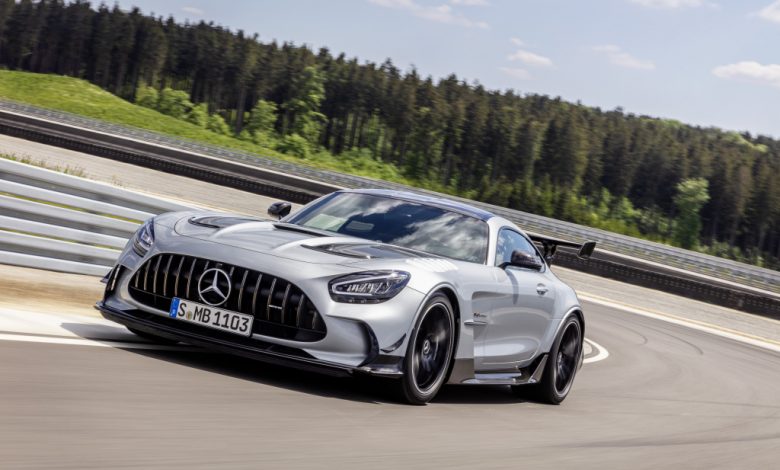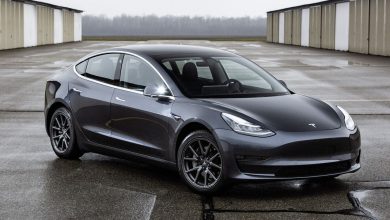Mercedes’ Lucifer Morningstar – The AMG GT Black Series
And when I say it is Lucifer, I mean it not only looks like the devil's ride but has enough performance to equal an F1 car on the road.

If the devil wears Prada, the devil must drive this new monster from Merc. Its called the AMG GT Black series and like any other Mercedes Black series model, its not meant for heart patients. With 730 HP from a flat crankshaft 4.0 litre bi-turbo V8, a 0-100KPH time of 3.2 seconds and 800NM of torque to the rear wheels, this is no more any other AMG.
Why is it Lucifer?
For starters, it looks like it will rip your soul apart. Secondly, with the specs it has, it probably is a punisher for those who try to drive it unless they really know how to. When Mercedes goes into Black series, they do not intend to make it for those relying solely on the car’s intelligent tech to put them through a track. That being said, it still has VERY clever tech, More on that later.
But, thirdly and most importantly, it is rear wheel drive with 730HP and 800NM of torque via a modified AMG SPEEDSHIFT DCT 7G transmission. So, the punishment will vary depending on how fast you’re going and how much do you rely on your own skills. I am finding myself confused whether this is the devil’s ride or the devil itself. Here, take a look. All that is missing is a set of glowing red lights.

Mercedes-AMG GT Black Series (combined fuel consumption: 12,8 l/100 km, combined CO2 emissions: 292 g/km), 2020, exterieur, race track, dynamic, front, radiator grille, front diffusor, Flics, Air Curtains, hightechsilver

Mercedes-AMG GT Black Series (combined fuel consumption: 12,8 l/100 km, combined CO2 emissions: 292 g/km), 20 20, exterieur, race track, dynamic, rear, double rear wing, exhaust System, hightechsilver

Mercedes-AMG GT Black Series (combined fuel consumption: 12,8 l/100 km, combined CO2 emissions: 292 g/km), 2020, exterieur, race track, dynamic, front, side, hightechsilver

Mercedes-AMG GT Black Series (combined fuel consumption: 12,8 l/100 km, combined CO2 emissions: 292 g/km), 2020, exterieur, race track, dynamic, rear, double rear wing, carbon elements, diffusor, hightech-silver

Mercedes-AMG GT Black Series (combined fuel consumption: 12,8 l/100 km, combined CO2 emissions: 292 g/km), 2020, exterieur, public road, dynamic, front, side, front diffusor, hightechsilver

Mercedes-AMG GT Black Series (combined fuel consumption: 12,8 l/100 km, combined CO2 emissions: 292 g/km), 2020, exterieur, race track, dynamic, front, hightechsilver
The engineering craftsmanship
So, we have already gone through all the specs and its got so much power, torque and tech etc. What does it actually mean? How is it so good? What modifications have been done to the normal AMG GT-R Pro which was already a pretty impressive track tool.
Well, the power increment is actually fascinating. They didn’t add a bigger engine or anymore weight. They used a flat crankshaft. For automotive nerds like myself, this is interesting. The design of a V8 engine gives designers plenty of room to play with in one key element: the crank arrangement on the crankshaft. This influences the characteristics of the engine. There are usually two variants in V8 engines: the ‘cross plane’ where the crankpins of the four pairs of cylinders are at 90-degree angles to each other, which AMG has used in all previous V8 engines, or the ‘flat crankshaft’, where all crank pins are on the same plane with a 180-degree offset (‘flat plane’).

Mercedes-AMG GT Black Series (combined fuel consumption: 12,8 l/100 km, combined CO2 emissions: 292 g/km), 2020, ext erieur, race track, dynamic, leightweight-roof in visible caron, hightech-silver

Mercedes-AMG GT Black Series (combined fuel consumption: 12,8 l/100 km, combined CO2 emissions: 292 g/km), 2020, exterieur, race track, dynamic, leightweight-roof in visible carbon, hightechsilver, carbon hood with two large air outlets

Mercedes-AMG GT Black Series (combined fuel consumption: 12,8 l/100 km, combined CO2 emissions: 292 g/km), 2020, Exterieur, front, front diffusor, radiator grille, side, hightechsilver

Mercedes-AMG GT Black Series (combined fuel consumption: 12,8 l/100 km, combined CO2 emissions: 292 g/km), 2020, exterieur, race track, dynamic, leightweight-roof in visible carbon, hightechsilver, carbon hood with two large air outlets
A cross-plane V8 is known for signature V8 sounds and giving high torque output at low rotational speeds i.e. at lower RPM bands. But, just because this is a flat plane doesn’t mean it can’t sound good. Boffins at AMG have essentially moved the exhaust side into the hot internal V of the two cylinder banks in the V8 engine, This also takes full use of the displacement. In the flat-plane V8 engine, it looks like an inline four-cylinder model – except for the wider crankpins. These have two connecting rods each in the V8. Ignition in the flat-plane V8 jumps from one cylinder bank to the next improving the gas cycle.
The characteristic firing order with a 180-degree crankshaft angle offset is 1-8-2-7 4-5-3-6. To understand better, you can write down these numbers in the order of the firing pistons. Then, consider the movement as per the above firing order. This firing order creates uniformly oscillating gas columns in the exhaust tract and on the intake side, whose resonance can easily be used to increase performance. An even greater advantage is a more agile throttle response.
Aerodynamics
As with the AMG GT R and AMG GT R PRO, aerodynamics experts and designers have worked in close collaboration, as ‘form follows function’ applies more than ever in the case of the Black Series. new, significantly larger radiator air inlet, which stems directly from the AMG GT3 racing car.
The radiator trim has vertical struts in dark chrome, because now that the wheel arch coolers are also fed with air directly via the central inlet, there is no need for the two additional outer air inlets in the front apron. Sickle-shaped flics optimise the flow of air here, which not only increases down force at the front axle, but also improves brake cooling.
The ‘air curtains’ control and direct the flow towards the wheels. Together with the flics in front of the wheels, this serves to reduce the drag coefficient and increase downforce. The new design language therefore combines maximum cool air efficiency with lower air resistance and an increased level of downforce at the front.

Mercedes-AMG GT Black Series (combined fuel consumption: 12,8 l/100 km, combined CO2 emissions: 292 g/km), 2020, Exterieur, front, front diffusor, aerodynamics, hightechsilver

Mercedes-AMG GT Black Series (combined fuel consumption: 12,8 l/100 km, combined CO2 emissions: 292 g/km), 2020, Exterieur, front, front diffusor, aerodynamics, hightechsilver, Radiator grille
The carbon-fibre front splitter has two manually adjustable settings (Street and Race – Race exclusively for use on racetracks) and can therefore be adapted to meet various track requirements. When extended forward (Race position), a front diffuser in the shape of a reversed wing profile is then created under the front section.
Depending on the driving speed, this element is lowered even further by the rising negative pressure, which significantly accelerates the air flow on the underbody, creating a ‘Venturi effect’, which also draws the car closer to the road and increases downforce on the front axle. The driver can feel the benefits in the steering: The Black Series can be steered even more precisely when cornering at high speed and exhibits even better directional stability.
While these things can only be experienced after an actual drive in the car, it appears from the above info that the steering feedback must be better at high cornering speeds and even lateral acceleration. It should technically be under control all the time now.

Mercedes-AMG GT Black Series (combined fuel consumption: 12,8 l/100 km, combined CO2 emissions: 292 g/km), 2020, Exterieur, rear, double rear wing, aerodynamics, hightechsilver

Mercedes-AMG GT Black Series (combined fuel consumption: 12,8 l/100 km, combined CO2 emissions: 292 g/km), 2020, Exterieur, rear, exhaust system
Another direct derivative from motorsport is the new carbon-fibre bonnet, with two large exhaust air outlets made from black finished carbon surfaces. The large outlets guide the warm air, which is fed from the diagonally positioned cooling pack, out of the engine compartment. This technology is also directly derived from motorsport and increases the overall downforce. At the same time, the air resistance is reduced, and the air mass flow for cooling the engine is optimised.

Mercedes-AMG GT Black Series (combined fuel consumption: 12,8 l/100 km, combined CO2 emissions: 292 g/km), 2020, exterieur, aerodynamic, hightechsilver, front

Mercedes-AMG GT Black Series (combined fuel consumption: 12,8 l/100 km, combined CO2 emissions: 292 g/km), 2020, exterieur, aerodynamic, hightechsilver, side perspective
The new Aerofoil concept
The warm air from those large outlets on the carbon bonnet is specifically guided around the A-pillars and side windows to the rear. This increases the efficiency of the new rear aerofoil concept. The rear view is characterised by the new rear apron with a large diffuser, two rounded twin tailpipe trims on the outside left and right, side wheel arch ventilation, and the innovative rear aerofoil concept. Both aerofoil blades are made from carbon fibre, can be mechanically adjusted and therefore adapted to various track conditions.
The second, lower positioned blade was made particularly small and narrow because this is ideal for the air arriving from the front of the car. The light yet robust carbon-fibre aerofoil supports, painted matt black and specially designed based on extensive simulations also increase aerodynamic efficiency. They are bolted to the carbon-fibre tailgate, which is also black.
Even more fascinating is the movable flap in the upper blade. This active aerodynamic element is electronically adjusted by 20 degrees, to suit the driving situation and selected AMG DYNAMICS mode, and improves longitudinal and transverse dynamics. In a flat position, it reduces the air resistance, to help reach the top speed more quickly. In the inclined position, the flap improves braking performance and cornering stability thanks to increased downforce at the rear axle.
The AMG DYNAMICS mode
Four different activation strategies can be run, depending on whether AMG DYNAMICS Basic, Advanced, Pro or Master has been selected. Some of these strategies also involve driving dynamics recognition, for example, Master: The flap is permanently inclined and extended up to 250 km/h. When the speed exceeds 250 km/h, it retracts in order to reduce the air resistance and thus reach the top speed more quickly.
However, if the driver brakes suddenly or steers into a corner, the flap immediately returns to its extended position in order to optimise braking and cornering thanks to increased downforce and air resistance. The flap can also be retracted or extended by the driver using a separate button in the centre console. So, as I said before, this is no more a supercar for those relying solely on technology. You have to be a master of driving to drive this AMG in the Master mode.
Almost full underbody panelling
However, if the driver brakes suddenly or steers into a corner, the flap immediately returns to its extended position in order to optimise braking and cornering thanks to increased downforce and air resistance. The flap can also be retracted or extended by the driver using a separate button in the centre console. The result is better air flow and downforce. The downforce level is well over 400 kilograms at 250 km/h which is almost shifitng towards the hypercar territory.
Suspension, traction control and weight
The coil over suspension with adjustable and adaptive dampening is carried over from the GT-R with technology which is adapted to meet the specific requirements for extreme racetrack use with high damping forces. The technology familiar from motorsport is combined with the AMG RIDE CONTROL continuously variable, adaptive damping system.
The double wishbone concept locates the wheel with high camber and toe-in stability. This enables high cornering speeds and gives the driver optimum road feel when cornering at the extreme limits. Wishbones, steering knuckles and hub carriers on the front and rear axle are made entirely from forged aluminium in order to reduce the unsprung masses. The spherical bearings on the upper and lower wishbones of the rear axle come straight from motorsports.
The extreme use of carbon fibre and more lightweight components simply means a better power to weight ratio. Although we have no exact figures of weight saving, I guess it wouldn’t be much considering how light the AMG GTR Pro already was. Still, the lightweight carbon-fibre roof, with a sunken centre, as well as the carbon-fibre tailgate with small spoiler lip and larger rear windscreen made from lightweight thin glass, are all key components of the ‘intelligent material mix’ and ‘lightweight construction’. Moving to the front of the car, the glass used to make the laminated glass windscreen is likewise thin and therefore light in weight.

Mercedes-AMG GT Black Series (combined fuel consumption: 12,8 l/100 km, combined CO2 emissions: 292 g/km), 2020, Black Series fam ily, C 63 AMG Coupé Black Series, CLK 63 AMG Black Series, SLK 55 AMG Black Series, SL 63 AMG Black Series, SLS AMG Black Series

Mercedes-AMG GT Black Series (combined fuel consumption: 12,8 l/100 km, combined CO2 emissions: 292 g/km), 2020, Exterieur, front, front diffusor, radiator grille, side, hightechsilver

Mercedes-AMG GT Black Series (combined fuel consumption: 12,8 l/100 km, combined CO2 emissions: 292 g/km), 2020, exterieur, public road, dynamic, front, side, front diffusor, hightechsilver
For use on cordoned-off racetracks in ESP OFF mode, the AMG TRACTION CONTROL enables the driver to get individual support for controlling the immense power of the Black Series – and without any ESP brake intervention whatsoever. The level of support can be fine-tuned, providing the ideal level of assistance for each driver and each track situation.
The AMG TRACTION CONTROL has been extensively tailored to meet the requirements of the new Black Series and allows preselection of one of nine slip settings on the live rear axle. Control is exclusively via corresponding maps in the engine electronics and without any intervention in the ESP system, as is also the case with the GT3 racing car.
Interior
The interiors haven’t been changed all that much. Obviously! The focus in these kinds of cars is more on removing things than adding them. Except for the price that is. The new centre console and button layout has been altered to resemble a V8 engine. There is a 10-inch driver’s display and a 12-inch infotainment screen with Mercedes’ MBUX system. The grab handles have also been replaced with those alcantara ones instead of solid carbon fibre or plastic. I never see a point of these because how much weight can you save. But what do I know eh!

Mercedes-AMG GT Black Series (combined fuel consumption: 12,8 l/100 km, combined CO2 emissions: 292 g/km), 2020, Interieur, Steering wheel, AMG performance steering wheel microfibre DINAMICA with AMG steering wheel buttons

Mercedes-AMG GT Black Series (combined fuel consumption: 12,8 l/100 km, combined CO2 emissions: 292 g/km), 2020, Interieur, seat, AMG seat in carbon with orange contrast stitching

Mercedes-AMG GT Black Series (combined fuel consumption: 12,8 l/100 km, combined CO2 emissions: 292 g/km), 2020, Interieur, traction control
The price of this beast will be well above the normal GT-R Pro and so will be its exclusivity. Again, obviously!But, it will definitely keep its value so you don’t have to think twice if you have the money.




